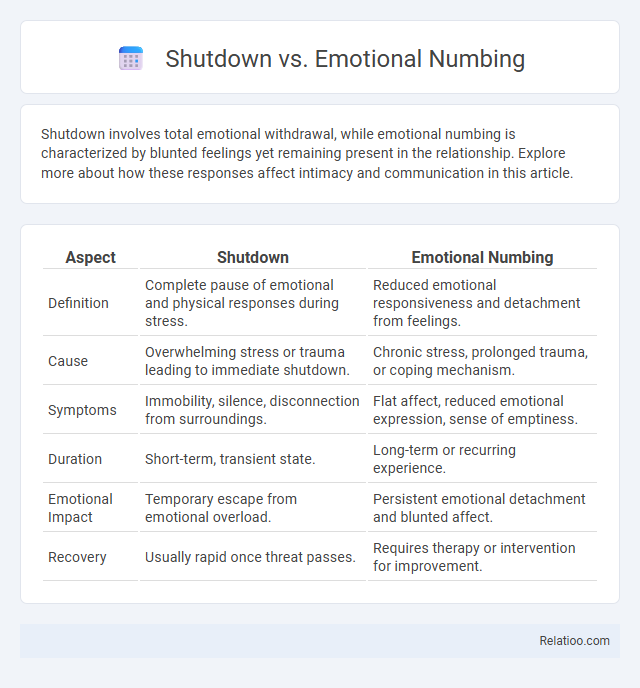Shutdown involves total emotional withdrawal, while emotional numbing is characterized by blunted feelings yet remaining present in the relationship. Explore more about how these responses affect intimacy and communication in this article.
Table of Comparison
| Aspect | Shutdown | Emotional Numbing |
|---|---|---|
| Definition | Complete pause of emotional and physical responses during stress. | Reduced emotional responsiveness and detachment from feelings. |
| Cause | Overwhelming stress or trauma leading to immediate shutdown. | Chronic stress, prolonged trauma, or coping mechanism. |
| Symptoms | Immobility, silence, disconnection from surroundings. | Flat affect, reduced emotional expression, sense of emptiness. |
| Duration | Short-term, transient state. | Long-term or recurring experience. |
| Emotional Impact | Temporary escape from emotional overload. | Persistent emotional detachment and blunted affect. |
| Recovery | Usually rapid once threat passes. | Requires therapy or intervention for improvement. |
Understanding Shutdown and Emotional Numbing
Shutdown is a psychological response where an individual becomes unresponsive or detached due to overwhelming stress or trauma, often characterized by physical and emotional withdrawal. Emotional numbing specifically refers to the reduced ability to experience emotions, which can be a symptom of shutdown but may also occur independently in conditions like PTSD or depression. Understanding shutdown and emotional numbing involves recognizing how the brain suppresses emotional responses to protect the individual from further distress, which can impair social interactions and emotional processing.
Key Differences Between Shutdown and Emotional Numbing
Shutdown involves a temporary, intense loss of physical and emotional responsiveness often triggered by overwhelming stress, whereas emotional numbing is a more prolonged state characterized by reduced emotional awareness and blunted feelings. Shutdown typically manifests as a survival mechanism during acute trauma, leading to immobility or dissociation, while emotional numbing occurs over time as a coping strategy to chronic stress or psychological pain. Key differences include the immediacy and duration of symptoms, with shutdown being sudden and short-lived, and emotional numbing developing gradually with persistent emotional detachment.
Common Triggers of Emotional Shutdown
Emotional shutdown often results from overwhelming stress, trauma, or intense fear, leading the brain to temporarily block emotional responses for self-protection. Common triggers include prolonged anxiety, feelings of helplessness, social rejection, and sensory overload, which prompt dissociation and detachment from emotions. These shutdowns differ from emotional numbing by involving a more acute, automatic response that abruptly limits emotional experience to avoid further psychological harm.
Psychological Roots of Emotional Numbing
Emotional numbing originates from the brain's defense mechanisms against intense trauma or chronic stress, often linked to disruptions in the amygdala and prefrontal cortex functioning. Unlike shutdown, which is characterized by a complete physiological and cognitive disengagement, emotional numbing involves a selective dampening of feelings to protect the individual from overwhelming emotions. Understanding these psychological roots is crucial for targeted therapy, as emotional numbing reflects an adaptive yet maladaptive response to psychological pain.
Behavioral Signs of Shutdown vs Emotional Numbing
Behavioral signs of shutdown include withdrawal from social interaction, reduced physical activity, and minimal verbal communication, indicating an overwhelmed nervous system attempting to conserve energy. In contrast, emotional numbing manifests as a flattened affect, lack of emotional responsiveness, and diminished ability to experience pleasure, reflecting a psychological defense mechanism against distressing emotions. Distinguishing shutdown from emotional numbing involves observing whether the response is primarily physical and behavioral or related to emotional detachment and blunted affect.
Impact on Relationships and Social Connections
Shutdown, emotional numbing, and shutdown are distinct psychological responses that significantly impact relationships and social connections. Shutdown involves a complete withdrawal from social interaction, leading to isolation and difficulty maintaining close bonds. Emotional numbing reduces the ability to express or feel emotions, causing detachment and misunderstandings that strain communication and empathy in relationships.
Coping Mechanisms for Shutdown and Numbing
Coping mechanisms for shutdown and emotional numbing involve grounding techniques, mindfulness practices, and seeking professional support to reconnect with your emotions safely. Developing awareness of physical sensations and practicing controlled breathing can help mitigate the overwhelming effects of shutdown. Utilizing these strategies allows you to regain emotional balance and improve your overall mental resilience.
Therapeutic Approaches and Interventions
Therapeutic approaches for managing shutdown, emotional numbing, and shutdown symptoms emphasize trauma-informed care, cognitive-behavioral therapy (CBT), and mindfulness-based techniques to help regulate emotional responses. Interventions such as grounding exercises, somatic experiencing, and dialectical behavior therapy (DBT) can effectively assist Your nervous system in re-engaging with emotions and reducing dissociative states. Personalized treatment plans that address individual triggers and resilience-building promote long-term emotional healing and functional recovery.
When to Seek Professional Help
Seek professional help if emotional shutdown or numbing persistently impair daily functioning, relationships, or mental health. Symptoms such as prolonged inability to express emotions, detachment from reality, or overwhelming stress require intervention from a licensed therapist or psychiatrist. Early treatment can prevent escalation to more severe conditions like depression, anxiety disorders, or PTSD.
Building Emotional Resilience and Healing
Shutdown involves a temporary inability to respond to emotional or sensory stimuli, whereas emotional numbing is a persistent reduction in emotional responsiveness. Building emotional resilience requires practices like mindfulness, self-awareness, and therapeutic interventions to process trauma and regain emotional regulation. Healing emerges through gradual reconnection with feelings, cognitive reframing, and supportive environments that reinforce emotional safety and expression.

Infographic: Shutdown vs Emotional Numbing
 relatioo.com
relatioo.com